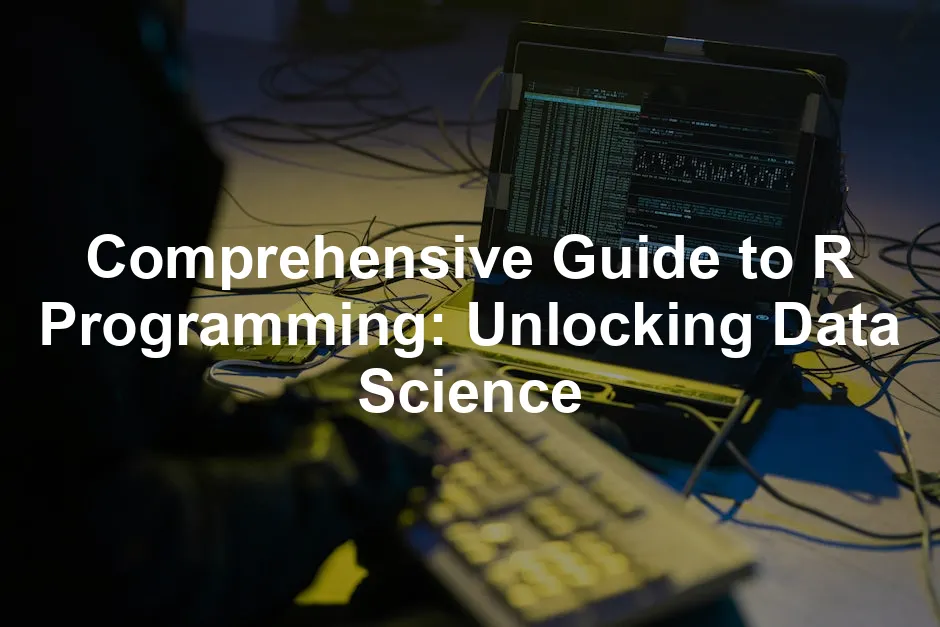Introduction
R programming stands out as a powerful tool for statistical computing. Its robust features enable data analysis with ease. R is incredibly popular among data scientists and analysts. This article aims to provide a comprehensive overview of R programming. We’ll cover its features, applications, and the supportive community surrounding it.
If you’re looking for a solid foundation in R, consider picking up R Programming for Data Science by Roger D. Peng. This book is perfect for beginners and seasoned programmers alike, providing a clear and engaging introduction to the world of R.
Summary and Overview
In this article, we will cover several key points about R programming. First, we will explore the importance of R in the data science ecosystem. R is essential for statistical analysis and provides a rich set of tools for data visualization. We will also discuss its open-source nature, making it accessible to everyone. Additionally, R has a vibrant community that actively contributes to its continuous improvement. Various industries, including finance, healthcare, and academia, utilize R for data-driven decision-making. By the end, you’ll understand why R is a go-to language in data science.

Understanding the importance of R in data science can be further explored in this article on tips for effective data analysis in economics and statistics.
What is R Programming?
R programming is an environment and language designed for statistical computing and graphics. Developed by Ross Ihaka and Robert Gentleman in the early 1990s, R has evolved significantly over the years. It began as an academic project at the University of Auckland and has grown into a powerful tool used globally.
R consists of two main components: the R language itself and a runtime environment. The language is specifically tailored for statistical analysis, making it distinct from general programming languages like Python. R’s core functionalities include various statistical techniques, data manipulation, and visualization capabilities.
The language’s syntax is user-friendly, allowing statisticians and data analysts to perform complex calculations easily. Furthermore, R supports a wide range of packages that extend its functionality, enabling users to tackle diverse analytical challenges. In summary, R programming is an essential tool for anyone interested in data analysis and statistical computing.

If you’re interested in diving deeper into R programming, you might find The Art of R Programming: A Tour of Statistical Software Design by Norman Matloff to be an enlightening read. This book teaches you the intricacies of R while providing a solid understanding of statistical software design.
Features of R
R programming is packed with features that make it a favorite among data scientists. One of its standout qualities is its extensive range of statistical packages and libraries. As of October 2024, the Comprehensive R Archive Network (CRAN) boasts over 21,513 packages, providing users with powerful tools for various statistical techniques. This vast array of resources allows you to perform everything from basic analyses to complex modeling.
Another impressive feature is R’s exceptional data visualization capabilities. The popular ggplot2 package enables users to create intricate and visually appealing graphics. With a few lines of code, you can generate everything from simple plots to elaborate multi-layered visualizations. This makes R perfect for users who want to present data in a clear and engaging way.

R’s ability to integrate with other programming languages is also noteworthy. You can easily incorporate Python or C++ code into R, enhancing its functionality. This extensibility allows users to leverage the strengths of multiple languages, making R a versatile choice for various data science tasks.
Overall, R’s combination of statistical prowess, visualization power, and integration capabilities make it a top choice for data analysis and machine learning. If you’re looking for a comprehensive guide to mastering R, R for Data Science: Import, Tidy, Transform, Visualize, and Model Data by Hadley Wickham is an excellent resource.

Getting Started with R
Ready to jump into R programming? The first step is to install R and RStudio, a powerful IDE that enhances your coding experience. Head over to the official R Project website to download the latest version compatible with your operating system. Follow the installation instructions, and you’ll be up and running in no time.
Once R is installed, download RStudio. This user-friendly interface simplifies coding and provides helpful tools for data visualization and package management. After installation, you can start your first R session.
Basic R syntax is relatively straightforward. R uses assignment operators, like <-, for variable assignment. For example, x <- 5 assigns the value 5 to x. You can perform calculations easily: y <- x + 10 adds 10 to x and stores the result in y.
For beginners, there are numerous resources available online. Websites like Coursera and Codecademy offer courses specifically tailored for R. You can also find countless tutorials on YouTube and blogs dedicated to R programming. These resources will help you build a solid foundation and advance your skills.

If you’re keen on learning from the ground up, check out Data Science for Dummies by Judith Hurwitz. This book is an excellent introduction for those new to data science and programming.
Basic Syntax and Data Types
Understanding R’s basic syntax and data types is essential for effective programming. R supports several data structures, including vectors, lists, and data frames. Vectors are the simplest data type, storing a sequence of values. For instance, you can create a vector of numbers like this:
numbers <- c(1, 2, 3, 4, 5)Lists are more flexible, allowing you to store different data types, such as numbers and strings. You can create a list like this:
my_list <- list(name = "Alice", age = 30, scores = c(90, 85, 88))Data frames are crucial in R, as they hold tabular data. You can create a data frame using:
my_data <- data.frame(Name = c("Alice", "Bob"), Age = c(30, 25))These basic structures form the foundation of data manipulation in R, enabling you to handle and analyze data effectively. If you’re looking for a thorough guide on data manipulation, R Cookbook: Proven Recipes for Data Analysis, Statistics, and Graphics by Paul Teetor will serve you well.

R in Data Science
R plays a pivotal role in data science workflows. It simplifies complex data tasks, making it an essential tool for analysts and statisticians. With its rich array of functions, R excels in data cleaning, manipulation, and analysis. This versatility allows users to extract valuable insights from raw data efficiently.
Data cleaning is often the first step in any project. R’s packages, such as dplyr and tidyr, streamline this process. dplyr offers straightforward functions to filter, arrange, and summarize data. With tidyr, you can reshape your data into a tidy format, which is crucial for effective analysis. These tools make it easy to manage messy datasets.
When it comes to data manipulation, R shines with its powerful capabilities. You can easily perform operations like merging datasets, handling missing values, and transforming variables. This flexibility is vital in preparing data for analysis, ensuring accuracy and consistency.
R is also a powerhouse for data analysis. You can conduct statistical tests, build models, and generate predictions with ease. Its extensive suite of packages, including ggplot2 for visualization, enhances your ability to communicate findings effectively. You can create stunning charts and graphs to present your results clearly.

Additionally, R’s community continuously develops and contributes packages, expanding its functionalities. This collaborative environment fosters innovation, keeping R at the forefront of data science tools. Whether you are cleaning data, manipulating it, or analyzing it, R provides the resources and support you need to succeed in your projects.
If you want to dive deeper into data visualization, look no further than Data Visualization: A Practical Introduction by Kieran Healy. This book provides a fantastic approach to visualizing data using R.

R vs Python: A Comparative Study
R and Python are two of the most popular programming languages in data science. Each has its unique strengths and weaknesses, making them suitable for different tasks.
R is particularly strong in statistical analysis and data visualization. Its extensive library of packages, such as ggplot2 and dplyr, makes it easy to perform complex analyses and create visually appealing graphics. If your primary focus is statistical modeling, R is often the go-to choice.
On the other hand, Python offers versatility beyond data analysis. It excels in general programming and machine learning. Libraries like pandas and scikit-learn provide robust tools for data manipulation and predictive modeling. If your work involves deploying models into production or integrating with web applications, Python may be more suitable.
Choosing between R and Python often depends on your specific needs. For purely statistical analysis or academic research, R might be the better option. If you require a language that supports a broader range of applications, including software development, Python could be your best bet.
In summary, both languages have their place in the data science toolkit. Understanding their strengths can help you select the right one for your project.

Advanced Features of R
R offers advanced capabilities that make it a powerful tool for data science. Its features extend beyond basic analysis to include machine learning, simulation, and statistical modeling.
Machine learning is one area where R truly excels. Libraries like caret and randomForest enable users to build complex predictive models easily. With caret, you can streamline the process of training and tuning models, making it accessible even for beginners. randomForest allows you to create robust models that are less prone to overfitting.
Statistical modeling is another strong suit of R. The language supports a wide range of techniques, from linear regression to more complex methods like generalized linear models (GLMs). This flexibility allows you to approach various problems with the right statistical tools.
Simulation is also a key feature of R. You can create simulations to understand the behavior of statistical models under different conditions. This capability is invaluable for researchers and analysts looking to predict outcomes based on varying inputs.

Overall, R’s advanced features equip users to tackle complex data science challenges. Its extensive libraries and community support ensure that you have the tools necessary to succeed in any analytical endeavor. Embracing R opens the door to a world of possibilities in statistical analysis and machine learning. For a deeper dive into advanced R programming, check out Advanced R by Hadley Wickham.

The R Community and Resources
The R community is thriving and incredibly supportive. It plays a vital role in the growth and evolution of R programming. You can find numerous user groups, forums, and conferences that foster collaboration and knowledge sharing. One notable event is UseR!, an annual conference dedicated to R enthusiasts. Here, users gather to share insights, techniques, and recent advancements in the R ecosystem.
Online resources are plentiful and accessible. The Comprehensive R Archive Network (CRAN) is a treasure trove of R packages and documentation. You can explore it at CRAN. For official information, the R Project website offers valuable details on R’s features and updates. Additionally, forums like Stack Overflow and RStudio Community provide platforms for users to seek help and share experiences.

Engaging with these resources not only enhances your skills but also connects you with a global network of R users. If you’re looking for a comprehensive guide to help you navigate R’s resources, consider The R Book by Michael J. Crawley. This book covers a wide range of topics and is a valuable resource for R users at all levels.

Case Studies and Applications of R
R programming finds applications across various industries, showcasing its versatility. In finance, R is used for risk analysis and portfolio management. For instance, Bank of America employs R to analyze market trends and make data-driven decisions. R’s statistical capabilities enable financial analysts to perform complex calculations efficiently.
In healthcare, R aids in analyzing clinical trial data. A prominent example is the work done by researchers at the Mayo Clinic, who utilize R for statistical analysis of patient outcomes. By leveraging R’s extensive packages, they can visualize data effectively and draw meaningful insights to improve patient care.
Academia also benefits from R’s robust statistical tools. Researchers utilize R for data analysis in studies across disciplines, from psychology to environmental science. The use of R in academic settings highlights its importance in validating research through data analysis.

These case studies illustrate R’s capacity to handle real-world data challenges. As more industries adopt R, its significance in data science continues to grow, providing valuable solutions to complex problems. For those interested in the intersection of data science and business, Data Science for Business: What You Need to Know about Data Mining and Data-Analytic Thinking by Foster Provost is a must-read.
Conclusion
R programming is essential in the data science landscape. Its powerful features and supportive community make it a top choice for data analysis. By exploring R, you can unlock new possibilities for understanding and interpreting data.
If you’re eager to start, consider diving into tutorials or joining the R community. You can also explore advanced features to broaden your skill set. Embrace R as a valuable tool for your data analysis needs and watch your capabilities flourish. For a holistic view of R’s applications in data analysis, R in Action: Data Analysis and Graphics with R by Robert I. Kabacoff offers great insights.
FAQs
What is R programming used for?
R is primarily used for statistical analysis, data manipulation, and creating visualizations. Its powerful libraries make complex statistical tests simple. R is popular in academia, industry, and research for its robust analytics capabilities.
Is R programming easy to learn?
While R has a learning curve, its syntax is designed for ease of use, especially for those familiar with statistics. Beginners often find the interactive environment helpful. With practice and the right resources, you can quickly grasp the fundamentals.
How does R compare to Python for data science?
R excels in statistical analysis and visualization, while Python is more versatile for general programming and machine learning. If your focus is purely on statistics, R might be a better choice. For broader applications, Python shines.
What are the best resources to learn R?
Many online courses, tutorials, and books are available, including those on Coursera and Codecademy. Websites like DataCamp and W3Schools also offer hands-on exercises. Books like ‘R for Data Science’ are excellent for deeper understanding.
Can R be used for machine learning?
Yes, R has several packages that facilitate machine learning, such as caret and randomForest. These packages provide tools for building and evaluating models, making R a strong choice for data-driven decision-making.
How do I install R and RStudio?
Installation guides are available on the official R Project website. Simply download the software and follow the setup instructions for your operating system. RStudio provides an excellent interface that enhances your coding experience.
What are R packages?
R packages are collections of functions and datasets that extend R’s capabilities for various statistical and graphical tasks. They allow users to perform specialized analyses without building everything from scratch. The Comprehensive R Archive Network (CRAN) hosts thousands of packages for diverse applications.
Please let us know what you think about our content by leaving a comment down below!
Thank you for reading till here 🙂
All images from Pexels




